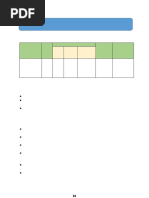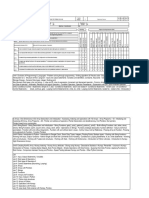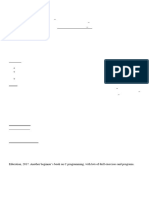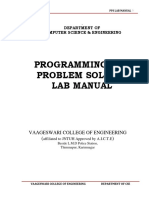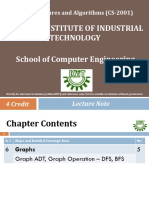EE233 Programming Lab
Uploaded by
Geor AlappEE233 Programming Lab
Uploaded by
Geor AlappCourse No.
Course Name L-T-P - Credits Year of
Introduction
EE233 PROGRAMMING LAB 0-0-3-1 2016
Course Objectives
To impart knowledge and develop skills in programming
List of Exercises/Experiments : (Minimum 12 exercises/experiments are mandatory)
1. At least four simple programs using input output statements (example: area of rectangle,
circle, etc)
2. At least four Simple programs using decision statements (Example: Even or odd, pass or
fail)
3. At least four Programs using Control statements and decision statements (Example
maximum, minimum of a given set of numbers, hcf, lcm)
4. Program to add n numbers
5. Programs to print patterns
6. Program to check whether a number is prime
7. program to generate Fibonaacii series
8. Array manipulation (searching, insertion and sorting)
9. Few programs using pointers
10. Functions Pass by value Pass by reference
11. Recursive functions (example: Fibonaacii series and factorial)
12.String manipulation – compare, copy, reverse operations
13. Matrix operations: addition multiplication, determinant and inverse
14. Reading from a file and writing to a file Merging and appending of files.
15. Solution of algebraic and transcendental equations: Bisection, Newton- Raphson
method- comparison
16. Introductory programs using Python
17. Function calls in Python
Expected outcome. 1. Ability to design programs using C language
2. Ability to develop simple programs using Python
References:
1. E. Balaguruswamy, Programming in ANSI C, Tata McGraw Hill, New Delhi
2. Kernighan, Brian W., and Dennis M. Ritchie. The C programming language. Vol. 2.
Englewood Cliffs: prentice-Hall, 1988.
3. Introduction to computation and programming using Python, John V. Guttag,
PHI Learning, New Delhi
4. Downey, Allen, Jeffrey Elkner, and Chris Meyers. How to think like a computer scientist:
learning with python. John Wiley 2015.
5. Lambert, Kenneth. Fundamentals of Python: first programs. Cengage Learning, 2011.
You might also like
- Second Semester B.tech. CSE- AIML, ECE and ICTNo ratings yetSecond Semester B.tech. CSE- AIML, ECE and ICT18 pages
- Signature Chairman BOS Signature Principal/DeanNo ratings yetSignature Chairman BOS Signature Principal/Dean7 pages
- Course Code CSE3011 Python Programming Course Type LP Credits 3No ratings yetCourse Code CSE3011 Python Programming Course Type LP Credits 33 pages
- Programming in C (CSE18R153) : School of Computing Departement of Computer Science and EngineeringNo ratings yetProgramming in C (CSE18R153) : School of Computing Departement of Computer Science and Engineering14 pages
- Programming in C (CSE18R153) : School of Computing Departement of Computer Science and EngineeringNo ratings yetProgramming in C (CSE18R153) : School of Computing Departement of Computer Science and Engineering14 pages
- CS F111 Computer Programming I Sem 2022-2023 HONo ratings yetCS F111 Computer Programming I Sem 2022-2023 HO5 pages
- CS F111 Computer Programming I Sem 2024-25 HONo ratings yetCS F111 Computer Programming I Sem 2024-25 HO5 pages
- Programming For Problem Solving Lab Manual: Vaageswari College of EngineeringNo ratings yetProgramming For Problem Solving Lab Manual: Vaageswari College of Engineering75 pages
- Syllabus - PROBLEM SOLVING USING PYTHON PROGRAMMING (I Year I Sem)No ratings yetSyllabus - PROBLEM SOLVING USING PYTHON PROGRAMMING (I Year I Sem)5 pages
- Unsorted 201129 Doc - Lagout.org Network Protocoles Reseaux Securisation En-Rapport Final Du Projet - Reseaux QuantiquesNo ratings yetUnsorted 201129 Doc - Lagout.org Network Protocoles Reseaux Securisation En-Rapport Final Du Projet - Reseaux Quantiques13 pages
- An Overview of Methods Maintaining Diversity in Genetic AlgorithmsNo ratings yetAn Overview of Methods Maintaining Diversity in Genetic Algorithms5 pages
- CS ZG524ES ZG524MEL ZG524 - Real Time Operating System - EC2 RegularNo ratings yetCS ZG524ES ZG524MEL ZG524 - Real Time Operating System - EC2 Regular3 pages
- CS8082U4L02 - Locally Weighted RegressionNo ratings yetCS8082U4L02 - Locally Weighted Regression13 pages
- MATH 371: Solutions To Practice Problems 1No ratings yetMATH 371: Solutions To Practice Problems 14 pages
- Math 443/543 Graph Theory Notes 5: Digraphs, Tra C, and TournamentsNo ratings yetMath 443/543 Graph Theory Notes 5: Digraphs, Tra C, and Tournaments3 pages
- Graph Theory and Nw Eqn Using KCL and KVLNo ratings yetGraph Theory and Nw Eqn Using KCL and KVL31 pages
- s18 Cu6051np Cw1 17031944 Nirakar SigdelNo ratings yets18 Cu6051np Cw1 17031944 Nirakar Sigdel18 pages


















